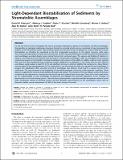Light-dependant biostabilisation of sediments by stromatolite assemblages
Abstract
For the first time we have investigated the natural ecosystem engineering capacity of stromatolitic microbial assemblages. Stromatolites are laminated sedimentary structures formed by microbial activity and are considered to have dominated the shallows of the Precambrian oceans. Their fossilised remains are the most ancient unambiguous record of early life on earth. Stromatolites can therefore be considered as the first recognisable ecosystems on the planet. However, while many discussions have taken place over their structure and form, we have very little information on their functional ecology and how such assemblages persisted despite strong eternal forcing from wind and waves. The capture and binding of sediment is clearly a critical feature for the formation and persistence of stromatolite assemblages. Here, we investigated the ecosystem engineering capacity of stromatolitic microbial assemblages with respect to their ability to stabilise sediment using material from one of the few remaining living stromatolite systems (Highborne Cay, Bahamas). It was shown that the most effective assemblages could produce a rapid (12-24h) and significant increase in sediment stability that continued in a linear fashion over the period of the experimentation (228h). Importantly, it was also found that light was required for the assemblages to produce this stabilisation effect and that removal of assemblage into darkness could lead to a partial reversal of the stabilisation. This was attributed to the breakdown of extracellular polymeric substances under anaerobic conditions. These data were supported by microelectrode profiling of oxygen and calcium. The structure of the assemblages as they formed was visualised by low-temperature scanning electron microscopy and confocal laser microscopy. These results have implications for the understanding of early stromatolite development and highlight the potential importance of the evolution of photosynthesis in the mat forming process. The evolution of photosynthesis may have provided an important advance for the niche construction activity of microbial systems and the formation and persistence of the stromatolites which came to dominate shallow coastal environments for 80% of the biotic history of the earth.
Citation
Paterson , D M , Aspden , R J , Visscher , P T , Consalvey , M , Andres , M , Decho , A W , Stolz , J & Reid , P R 2008 , ' Light-dependant biostabilisation of sediments by stromatolite assemblages ' , PLoS One , vol. 3 , no. 9 , 3176 . https://doi.org/10.1371/journal.pone.0003176
Publication
PLoS One
Status
Peer reviewed
ISSN
1932-6203Type
Journal article
Collections
Items in the St Andrews Research Repository are protected by copyright, with all rights reserved, unless otherwise indicated.

